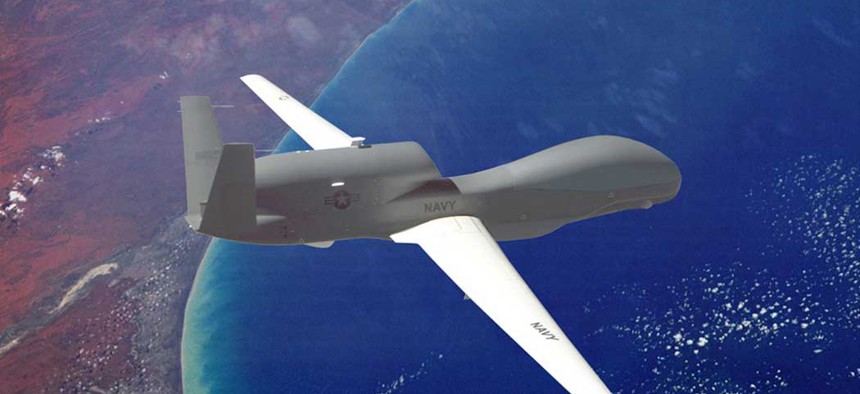Global Hawk takes another step toward replacing the U-2
Manufacturer Northrop Grumman said the unmanned aircraft successfully competed flight tests for the first time with the SYERS-2 sensor found on the U-2.
As the Air Force begins divestment of the venerated U-2 spy plane, the unmanned, de facto alternative RQ-4 Global Hawk will pick up the slack, including some of the sensors used on the older, but in some ways more capable, manned plane. This means retrofitting sensors and pods previously carried by the U-2.
Along those lines, Global Hawk manufacturer Northrop Grumman has announced that the aircraft successfully flew a Senior Year Electro-optical Reconnaissance System-2 (SYERS) sensor for the first time.
According to the Federation of American Sciences, SYERS is “the electro-optical daylight/fair weather imagery sensor” on the U-2, providing “deep look, high resolution, near-real-time imagery” to warfighters.
While the Air Force has viewed the U-2 and Global Hawk as complementary systems, the current budget environment doesn’t allow it to keep both. As costs for operating the Global Hawk fell below those of the U-2, the service chose to go with the unmanned platform going forward.
“The U-2 was decided upon as being retired and the Global Hawk going to pick up some of the –not all of – but some of the capabilities of the U-2,” said Lt. Col. Timothy McDonald, deputy of ISR Requirements at the Air Force’s Air Combat Command. “Now when it was designed, it wasn’t really designed to be a replacement for the U-2 and so we’re having to do a lot of adjustments to the RQ-4, the Global Hawk, in terms of capability to its sensors and that’s really what’s been consuming a lot of our time here at [Air Combat Command] is that issue with getting the Global Hawk to cover some of those capabilities that were identified as specifically being U-2.”
The Air Force is planning to spend up to $4 billion in modernization efforts over the next five years on the Global Hawk. “Our challenge is right now is how do we get those capabilities onto the RQ-4? It’s proving challenging … not only from a cost standpoint, but due to the size, weight and power limitations as well. [The Global Hawk] doesn’t have the same room and it doesn’t have the same payload capacity and it doesn’t have the same power that the U-2 has,” McDonald said.
Following the successful test of the SYERS-2 on the Global Hawk, Northrop said it plans to fly an Optical Bar Camera sensor and an MS-177 multi-spectral sensor – both sensors found on the U-2 – later in the year.
“This SYERS-2 flight is only the beginning. We firmly believe that with the addition of the UPA, Global Hawk is capable of flying any mission the U.S. Air Force requires,” said Mick Jaggers, vice president and program manager for Global Hawk unmanned aircraft system programs at Northrop. “Northrop Grumman is funding this study in order to prove that the system can affordably carry the same sensors as any other intelligence, surveillance and reconnaissance [ISR] aircraft. We look forward to continuing to work with our Air Force partners on this groundbreaking solution.”
NEXT STORY: Navy makes plans for cyber R&D





